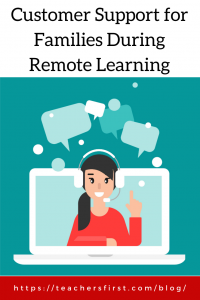 Unforeseen circumstances from the pandemic have repositioned schools to remote teaching and learning experiences. Teachers faced an enormous challenge of adapting their teaching to best meet the needs of their students. This shift in teaching and learning has also placed more responsibility on the shoulders of our students’ families. However, there is one thing that has not changed – the importance of connecting and communicating with our students and families.
Unforeseen circumstances from the pandemic have repositioned schools to remote teaching and learning experiences. Teachers faced an enormous challenge of adapting their teaching to best meet the needs of their students. This shift in teaching and learning has also placed more responsibility on the shoulders of our students’ families. However, there is one thing that has not changed – the importance of connecting and communicating with our students and families.
Our current situation has magnified the importance of communication and keeping our school community connected. Engaging, consistent and ample communication between teachers and families forges partnerships that benefit our students. All of these variables on top of a compressed time frame have underscored the need to support our families while acknowledging that they, too, are going through an unprecedented transition from face-to-face instruction to remote teaching.
Parent communication was a focus for one of our OK2Ask®️ bi-weekly Twitter Chats. The archive of the chat shares strategies on how to strengthen communication with families, tools to share information with students, as well as the importance of school-to-home communication. The information shared below outlines strategies for establishing a clear line of communication with our families during remote learning experiences.
Resource Selection
Use digital tools and resources that meet your students’ and families’ needs best. Just because another teacher is using it doesn’t mean it will work best for your situation. It’s also vital to remain consistent and not switch communication mediums for your families. Adjusting to remote learning is difficult for everyone, but changing communication tools and resources weekly adds unnecessary stress.
Synchronous versus Asynchronous
The abrupt transition to online instruction presents teachers with the challenge of offering synchronous and asynchronous opportunities to interact with students. Be mindful of the families’ schedules when offering synchronous learning opportunities. Some students may only have family support in the evening when their parents or guardians are home from work. Try to offer multiple times for synchronous learning activities and offer recordings for students to view if possible. Using synchronous and asynchronous learning opportunities can provide a more comprehensive online experience where personal aspects are supported.
Week-At-A-Glance
Outlining the entire week and sharing it in advance provides families the opportunity to plan ahead. It’s imperative to remember that many of our students’ families are also working. A family might be able to plan a much-needed activity away from the screen and complete school-related activities. Use a resource like Adobe Spark (Reviewed Here) or Microsoft Sway (Reviewed Here) to create an organized update to communicate the events and expectations for the next week of instruction. You could also record an audio update using Vocaroo (Reviewed Here) to meet the needs of families, or use Screencastify (Reviewed Here), designed only for use with the Chrome browser, to screen record a slide deck of information.
Tech It Out Night
Our schools must connect with our communities to establish relationships and educate our families on our classroom practices. We model expectations for our students, and it’s critical we do the same for our school community during remote learning. Hosting a Tech It Out Night for your families presents an opportunity to communicate with your school community to share your expectations and the resources you will use with the students throughout the remote learning experience. Use a video conferencing tool like Zoom (Reviewed Here) or Google Meet to connect with your families. Offer different times to best meet the needs of your family’s schedules and record the session to post on your communication mediums for families unable to attend. Share an overview and the technical requirements to participate in the meeting in advance. Organize your presentation to screen share during your Tech It Out Night using Google Slides (Reviewed Here) or PowerPoint (Reviewed Here). You can also record FAQ videos using a tool like Screencastomatic (Reviewed Here) for students and families to reference throughout the remote learning experience.
Multiple Means of Communication
Offering various means of communication provides families the opportunity to stay connected with the classroom. Some families may not have social media accounts or may prefer to receive their information through email. You can share links and information on social media sites like Twitter (Reviewed Here) or through text messages with Remind (Reviewed Here). Remember to be consistent with your communication with families and share the same information through all the mediums used for the classroom. Use Online Voice Recorder (Reviewed Here) to provide a link to an audio version of the information or record using a screencasting tool.
The COVID-19 pandemic has provided an opportunity to explore what technology can offer to enhance communication with our families. How are you communicating with your families and the school community? We would love to hear your thoughts and ideas about how to stay connected in the comments below.

